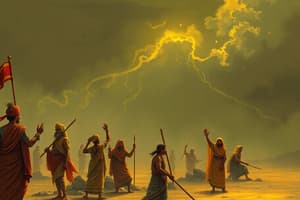Podcast
Questions and Answers
What was Periyar's motivation for founding the Self Respect Movement?
What was Periyar's motivation for founding the Self Respect Movement?
- He wanted to eliminate all social divisions and inequality.
- He was dissatisfied with the caste-based seating arrangements at a feast organized by nationalists. (correct)
- He believed that untouchables were the true upholders of an original Tamil and Dravidian culture. (correct)
- He believed that religious authorities saw social divisions and inequality as God-given. (correct)
What was the key goal of the Self Respect Movement?
What was the key goal of the Self Respect Movement?
- To promote the original Tamil and Dravidian culture.
- To challenge the influence of religious authorities.
- To achieve social equality for untouchables. (correct)
- To eliminate the caste system entirely.
How does the text characterize the impact of the movement for widow remarriage?
How does the text characterize the impact of the movement for widow remarriage?
- The movement was largely unsuccessful, but it helped raise awareness and generate public debate on widow remarriage. (correct)
- The movement was met with strong opposition, resulting in minimal impact on social practices.
- The movement was successful in gaining legal recognition but faced strong social resistance.
- The movement achieved widespread success, leading to a significant increase in widow remarriages.
Who was a key figure in the movement for widow remarriage in the Telugu-speaking areas of the Madras Presidency?
Who was a key figure in the movement for widow remarriage in the Telugu-speaking areas of the Madras Presidency?
Which of the following groups supported the movement for widow remarriage?
Which of the following groups supported the movement for widow remarriage?
Which of the following movements aimed at improving the social status of leatherworkers?
Which of the following movements aimed at improving the social status of leatherworkers?
Who actively challenged the caste system by questioning the Brahmanical texts?
Who actively challenged the caste system by questioning the Brahmanical texts?
What was the main reason for the opposition faced by Christian missionaries in India?
What was the main reason for the opposition faced by Christian missionaries in India?
Which group benefited from the reform activities of Christian missionaries?
Which group benefited from the reform activities of Christian missionaries?
What did E.V. Ramaswamy Naicker, also known as Periyar, do to improve the condition of untouchables?
What did E.V. Ramaswamy Naicker, also known as Periyar, do to improve the condition of untouchables?
What evidence suggests that E.V. Ramaswamy Naicker had a deep understanding of traditional Hindu scriptures?
What evidence suggests that E.V. Ramaswamy Naicker had a deep understanding of traditional Hindu scriptures?
Which of the following is NOT a reason why some people supported Christian missionaries?
Which of the following is NOT a reason why some people supported Christian missionaries?
What was the main objective of the movements organized by people from the lower castes?
What was the main objective of the movements organized by people from the lower castes?
Flashcards
Periyar
Periyar
A social reformer who founded the Self Respect Movement.
Self Respect Movement
Self Respect Movement
Movement founded by Periyar to promote dignity for untouchables.
Caste Distinctions
Caste Distinctions
Social hierarchy in India where upper and lower castes are segregated.
Widow Remarriage Movement
Widow Remarriage Movement
Signup and view all the flashcards
Arya Samaj
Arya Samaj
Signup and view all the flashcards
Caste Discrimination Movements
Caste Discrimination Movements
Signup and view all the flashcards
Satnami Movement
Satnami Movement
Signup and view all the flashcards
Matua Sect
Matua Sect
Signup and view all the flashcards
Shri Narayana Guru
Shri Narayana Guru
Signup and view all the flashcards
Christian Missionaries' Impact
Christian Missionaries' Impact
Signup and view all the flashcards
Opposition to Missionaries
Opposition to Missionaries
Signup and view all the flashcards
Support for Missionaries
Support for Missionaries
Signup and view all the flashcards
E.V. Ramaswamy Naicker
E.V. Ramaswamy Naicker
Signup and view all the flashcards
Study Notes
Caste-Based Movements in 19th Century India
- Lower castes organized movements against discrimination in the latter half of the 19th century, demanding social equality and justice.
- The Satnami movement, led by Ghasidas, worked to improve the social status of leatherworkers in central India.
- The Matua sect, led by Haridas Thakur in Eastern Bengal, challenged Brahmanical texts justifying caste.
- Shri Narayana Guru, an Ezhava guru in Kerala, advocated for unity and opposed caste-based inequality.
Opposition to Christian Missionaries
- Christian missionaries established schools for tribal and lower-caste children, advocating for social reforms and opposing caste, sati, and advocating education for girls.
- Missionaries faced opposition from orthodox sections of society, who viewed their actions as interfering in religious matters, suspecting their ultimate goal was conversion.
- Progressive Indians (reformers and intellectuals) and those benefiting from missionary reforms supported them.
E.V. Ramaswamy Naicker (Periyar)
- Periyar, a former ascetic, studied Sanskrit and later became a Congressman before distancing himself due to caste-based seating distinctions at a nationalist gathering.
- Founded the Self-Respect Movement to fight for the dignity of untouchables.
- He argued untouchables upheld an original Tamil/Dravidian culture, challenging religious authorities' view of caste as divinely ordained.
- He advocated for untouchables to free themselves from religious dogma to achieve social equality.
Widow Remarriage Movement
- Widow remarriage movements spread across India by the latter half of the 19th century.
- Reformers like Veerasalingam Pantulu in Telugu regions and young intellectuals in Bombay actively supported the cause.
- Swami Dayanand Saraswati's Arya Samaj also promoted widow remarriage.
- Despite efforts, the movement lacked widespread success, with few widows remarrying and facing social ostracization from conservative groups.
Studying That Suits You
Use AI to generate personalized quizzes and flashcards to suit your learning preferences.




